This article is by J. Conrad Matthews
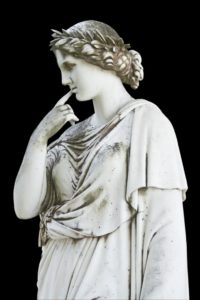
My wife and daughter asked me to watch a comedian on a talent competition. I needed a break from writing anyway. This was a good opportunity to convince my family was I a person and not part of the furniture that occasionally haunted the kitchen. I missed them a bit, too, but I’m not given to sentimentality.
We watched the comedian: he was good; he worked clean; and his jokes were not a simple repetition of everything we see in modern culture. I enjoyed it. I thought, ‘I’ll watch just one more’. I am glad I did.
The next act was a little girl just barely a teenager slender and coltish with a big shy smile full of teeth. She had a quiet polite voice and respectful manner both with her father and crew before she hit the stage and with the panelists. She was dressed both appropriately and modestly for her age. How could I not do her the courtesy of listening?
Then she sang. I an electric jolt of recognition hit me and I stood up. “It’s Janice Joplin!” burst out of me. I was as surprised as the rest of my family at my outburst.
My daughter disagreed saying the girl reminded her of Jagger on stage.
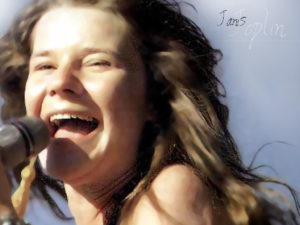
The original Janice Joplin
My wife and I agreed; it was pure Janice Joplin. I am in my sixth decade, and I have never felt that jolt of recognition like that before for the intangible. Then from comments that John C. Wright has made I realized what I was recognizing. It was the muse, that same muse that had poured from Joplin like a river of light was bursting from this girl like a firehose.
She could not remain still while she sung. Her movements were not the choreographed posturing of a bubble-gum popstar or coquettish girl posing provocatively. She was spontaneous and dynamic, and her music had the driving energy I had not heard live in over forty years.
It was the same muse. Whether there are three or nine or nine hundred that muse was the same energy that drove the young woman from Texas when she was on stage. My wife and I had no trouble recognizing it, and the panelists judging the girl did as well.
For me, it was an electric moment full of insight. I finally at the gut level understood what John C. Wright always wrote about praise for his writing. It was his muse that deserved the praise; he was just the instrument. That said, I do believe that Mr. Wright sells himself short in one regard. He does not get in his muse’s way.

J R R Tolkien
That girl didn’t just channel the muse into joyous song. She allowed the muse the full expression of the gift that it brought. That is what great artists and authors like John C. Wright, J.R.R. Tolkien, Stevie Ray Vaughn, Beethoven, do; they do not get in the way of the muse nor try and twist it to base ends.
Whether it is music, painting, art, storytelling, dance, or even martial arts there is a muse a spirit and energy that drives it, that courses through the artist. Looking at all art it is clear that beauty is the goal of the muse. It is a Superversive goal. All art even if it is painful, sad, or frightening, true art’s purpose and the muse driving it is to uplift people. To bring us closer to our creator and show us the glories that are ours to share in if we will only listen.
When an artist who is not inspired tries his hand at something it may be competent, it may be technically well done but without that inspiration it is merely that. There is nothing wrong with good art but inspired art is something else.
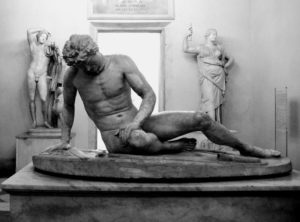
The Dying Gaul
The David Syndrome is the name given to the effect that Michelangelo’s David has on some viewers. They are overcome with emotion and put into a kind of shock. I felt the same the first time I saw The Dying Gaul as a boy in a museum. I felt the power of the dying man, the immediacy of it had me mesmerized until my grandmother gathered me up. I had seen people dying and dead up close from a car accident. That did not have this effect.
That is what an artist can achieve when they allow themselves to conform to what the muse is trying to express through the artist. An artist who denies that energy, that rejects the muse and tries to impose his own will upon the piece will to some degree or other fail. They will fail spectacularly like ‘Piss Christ’ (if indeed there was a muse involved at all) or they may find themselves blocked and unable to finish at all. It is not the muse blocking them it is their own desire to channel the energy in a way that it is not meant to go.
As I wrote above the muse is always uplifting. Even as I was stunned by the suffering and majesty of that image of the dying warrior naked and breathing his last, I was uplifted. I was not mesmerized because of his suffering and dying, I was mesmerized by the real live spirit that after thousands of years and who knows how many copies still shone through the artist’s hands who had first cast the now long-lost bronze.
A Good example of an artist that can channel the muse to uplift even in the darkest part of the story or art is J.R.R. Tolkien. Tolkien’s The Lord of the Rings took years of meticulous crafting to fashion but none of it strays from that ultimate goal of bringing people closer to the glory of God. There are moments of betrayal, Saurman who never repents, Boromir who does, and Wormtongue who commits the final sin of despair even as he dies. There are moments of heartbreak and tragedy as when Faramir falls to the black dart of the Witchking or Theoden lies broken beneath his faithful friend Snowmane but those moments are necessary. Light is featureless without contrast and the deeper the contrast the stronger the image that comes through.
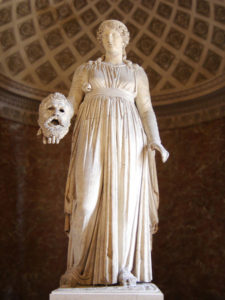
Muse with Tragedy Mask? Or Game of Thrones Character holding a severed head?
Contrast that to our American Tolkien, George R.R. Martin. He is a man of talent with good technical skills when he chooses to use them. Anyone who has read ‘Game of Thrones’ knows what he is capable of.
George R.R. Martin cannot finish a ‘Game of Thrones’ because he is standing in his own way. The muse may tell tales of murder, incest, betrayal and bitterness in order to contrast it to what is good or great, not as a celebration of the evil or as a way to torment and degrade the reader with sordid sin.
The harder Martin pushes against what the muse is trying to do (and over the centuries it is clear that these types of tales do have a path they want to travel) the more bound up he becomes. If you want to remain an artist you can only torture your art so far before it becomes ‘Piss Christ’ instead of Bouguereau’s ‘Pieta’. Martin is twisting the tale of the Once and Future King. The king that returns in the darkest hour to redeem the land and his people.
The tale is not always a happy one. The Young Princes died in the Tower and Arthur was betrayed by his son. However, that tale is a tale of hope even if it ends with a crippled uncle usurping the throne because God always puts it right. It might be an Aragorn that comes in from the wilderness to save his people or it might be David who defeats the giant when his own king and army is in despair. The promise of that story, the story that is trying to flow through Martin’s pen is that eventually a king will come again. Martin for personal reasons that become more obvious as the years pass, cannot tell that story. I do not think he understands heroism, love, strength, and sacrifice or that if he does understand it he rejects it as false or a weakness. It is not just his loss. As I wrote before he is a good writer, he simply cannot finish this tale. His ‘A Song of Ice and Fire’ could have been great it has fallen short of its promise and potential.
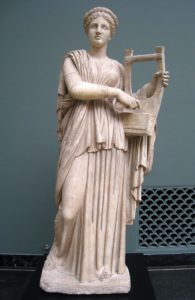 The reason I use ‘Piss Christ’ in contrast to Bouguereau’s ‘Pieta’ is simple. ‘Piss Christ’ simply fails. It fails in degrading and demeaning ways to not only the subject and the audience but to the artist himself.
The reason I use ‘Piss Christ’ in contrast to Bouguereau’s ‘Pieta’ is simple. ‘Piss Christ’ simply fails. It fails in degrading and demeaning ways to not only the subject and the audience but to the artist himself.
Contrast that with Bouguereau’s version of the famous moment that displays not only the suffering of Christ but that of his mother. Here the muse not only shows the ultimate sacrifice of Christ but that of his mother as well. Most other images of this moment show Mary with her eyes downcast in sorrow or lifted in heaven in full of tears. In Bouguereau’s version his muse showed the anger of a parent at the loss of her son. Mary is looking straight at the viewer. I have felt that loss and know that anger and know it is real. Of course, you feel the pain and sorrow but the anger is just as real and legitimate as well. Here the muse blazed a different trail. One that ‘Piss Christ’ for all its ‘daring’ could never do.
For far too long artists and especially writers have blocked or twisted their own muses. They either out of embarrassment or pride or their own expectations cannot allow that incandescent gift to shine through like that little girl who lit up the stage with a voice and a talent all out of proportion to her slender little body and tender years.
We should learn a lesson from people like Bouguereau, John C. Wright and that little singer. Cultivate your muse, be sensitive to it and by all means when it wants to tell a story, let it. Be the muse’s quill or voice use the blank canvas and let it come through. The muse is a higher spirit and it will lift you and your audience up if you let it.



